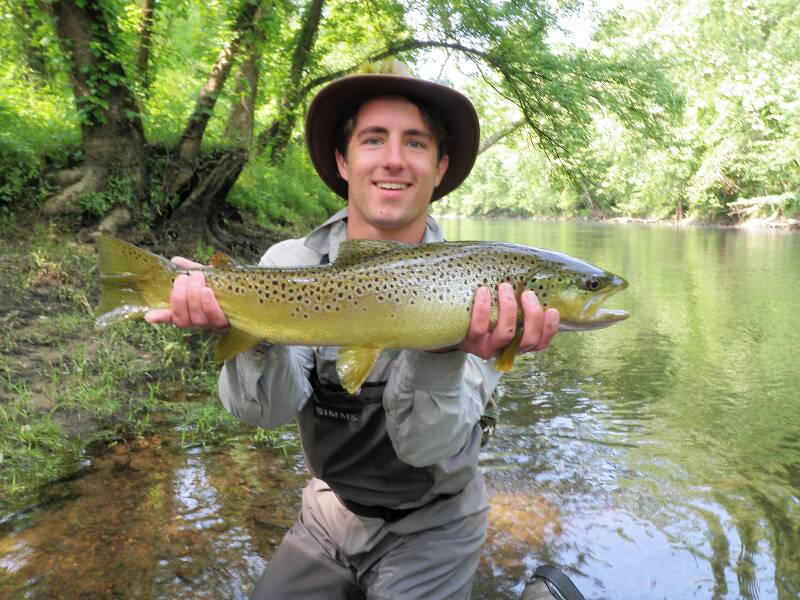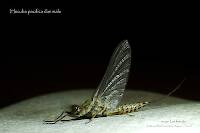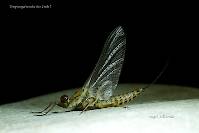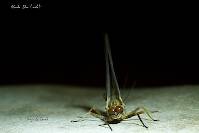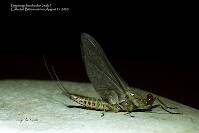
Hex Mayflies
Hexagenia limbata
The famous nocturnal Hex hatch of the Midwest (and a few other lucky locations) stirs to the surface mythically large brown trout that only touch streamers for the rest of the year.
Featured on the forum

It's only barely visible in one of my pictures, but I confirmed under the microscope that this one has a prosternal horn and the antennae are mid-way between the eyes and front of the head capsule.
I'm calling this one Pycnopsyche, but it's a bit perplexing. It seems to key definitively to at least Couplet 8 of the Key to Genera of Limnephilidae Larvae. That narrows it down to three genera, and the case seems wrong for the other two. The case looks right for Pycnopsyche, and it fits one of the key characteristics: "Abdominal sternum II without chloride epithelium and abdominal segment IX with only single seta on each side of dorsal sclerite." However, the characteristic "metanotal sa1 sclerites not fused, although often contiguous" does not seem to fit well. Those sclerites sure look fused to me, although I can make out a thin groove in the touching halves in the anterior half under the microscope. Perhaps this is a regional variation.
The only species of Pycnopsyche documented in Washington state is Pycnopsyche guttifera, and the colors and markings around the head of this specimen seem to match very well a specimen of that species from Massachusetts on Bugguide. So I am placing it in that species for now.
Whatever species this is, I photographed another specimen of seemingly the same species from the same spot a couple months later.
I'm calling this one Pycnopsyche, but it's a bit perplexing. It seems to key definitively to at least Couplet 8 of the Key to Genera of Limnephilidae Larvae. That narrows it down to three genera, and the case seems wrong for the other two. The case looks right for Pycnopsyche, and it fits one of the key characteristics: "Abdominal sternum II without chloride epithelium and abdominal segment IX with only single seta on each side of dorsal sclerite." However, the characteristic "metanotal sa1 sclerites not fused, although often contiguous" does not seem to fit well. Those sclerites sure look fused to me, although I can make out a thin groove in the touching halves in the anterior half under the microscope. Perhaps this is a regional variation.
The only species of Pycnopsyche documented in Washington state is Pycnopsyche guttifera, and the colors and markings around the head of this specimen seem to match very well a specimen of that species from Massachusetts on Bugguide. So I am placing it in that species for now.
Whatever species this is, I photographed another specimen of seemingly the same species from the same spot a couple months later.

Troutnut is a project started in 2003 by salmonid ecologist Jason "Troutnut" Neuswanger to help anglers and
fly tyers unabashedly embrace the entomological side of the sport. Learn more about Troutnut or
support the project for an enhanced experience here.
Sayfu
Posts: 560
Posts: 560
Sayfu on Sep 28, 2012September 28th, 2012, 7:32 am EDT
I look forward to fishing the riffles, and fishing small flies in the Fall. Swinging soft hackles, and fishing up riffle dries are my favorite way to fish. The water is low, and clear, and my riffles are easy to wade...BUT..we are still having warm nites. The water has cooled, but the fish are not in the riffles because there is nothing going on in the riffles. Trout are hold up on the fast water high banks side of the river in the pockets along the banks, and behind obstruction. The heavy wt.d streamer guys are catching fish, but I'm going without for the biggest part. Frustrating, and now we have snow predicted for next weekend. I do believe there is a carryover value for you on your stream as well.
Entoman on Sep 29, 2012September 29th, 2012, 3:05 am EDT
I've noticed fish don't move into the riffles until the evening in the Summer and early Fall (ex. the Deschutes). Same thing on the SF Snake?
"It's not that I find fishing so important, it's just that I find all other endeavors of Man equally unimportant... And not nearly as much fun!" Robert Traver, Anatomy of a Fisherman
Sayfu
Posts: 560
Posts: 560
Sayfu on Sep 29, 2012September 29th, 2012, 6:43 am EDT
Yes. My friends stripped big streamers with coneheads the other day while I was grouse hunting, then I drove their truck/trailer down to the takeout saving them a shuttle fee. The did well, and the guides were covering the same heavy water with nymphs, and catching fish for their clients avoiding the nice riffle water on the other side of the river. There just aren't any BWO,'s Mahoganies, Pink Alberts we call them showing on, or just off the riffles in heavier flow for the Yellow Quills I will call them this time. I attribute it to the balmy nites we are still having. I can still easily wet wade, the water temps around 58 degrees mid-morning. I see a few bugs coming off , but very few. If an angler saw how fast that flow is on the heavy water side you might think a trout would never hold there, but they do...in the protected pockets, and underwater obstruction. A big, bushy dry can pull fish up out of the pocket water, but it is just tough rowing, And I don't get especially enthralled out of rowing down through 100 yds of fast water trying to land a fish, skating them on top trying to get them in the net. I would much rather have my feet anchored, or the boat anchored.
Sayfu
Posts: 560
Posts: 560
Sayfu on Sep 29, 2012September 29th, 2012, 8:03 am EDT
What happens at nite is exciting for some. The ones that choose the full moon phase, and camp out in our SF Canyon. Browns will come out of that fast water, and chase minnows on, and just off the gravel bars. Some very big browns are caught at nite by these anglers.
Jesse on Sep 29, 2012September 29th, 2012, 10:06 am EDT
Was this simply a random post or what? I think I am missing the point here. Are you just telling us the up dates and what you wish to be doing?
Most of us fish our whole lives..not knowing its not the fish that we are after.
http://www.filingoflyfishing.com
http://www.filingoflyfishing.com
PaulRoberts on Sep 30, 2012September 30th, 2012, 5:24 am EDT
Yeah, I guess I was wondering specifically what you are meaning too. Ponderings about a given problem, but not well defined enough to be generalized, at least for me. Curious what you mean.
I guess I find fish feeding off riffles anytime of year, even dead of winter is conditions are right. What is special about the fall?
I guess I find fish feeding off riffles anytime of year, even dead of winter is conditions are right. What is special about the fall?
Sayfu
Posts: 560
Posts: 560
Sayfu on Sep 30, 2012September 30th, 2012, 6:11 am EDT
I posted it because I thought it could be generalized. Determining if fish are located in a riffle can be done fairly quickly by observation, I can cover water fairly fast swinging soft hackles, and determine if fish are located in riffle water, and observing bug activity. Then you can go to throwing streamers, or deep water nymphing. I have always, it seems anyway, had fish in the riffles by late Sept. and Oct for sure. This year? It has been a new experience, and I thought it had carry over value. And also value as far as Brown trout movement at nite, and where they can be caught in shallower water on, and just off the gravel bars. I actually developed large soft hackles, size #8 2-3XL hooks to fish in deeper water off the gravel bars as an approach when fish are not located in the riffles. This should have merit for wade fishermen since they have little alternatives.
PaulRoberts on Sep 30, 2012September 30th, 2012, 9:15 am EDT
I see. Hmmmm... I guess I don't have as much experience with larger rivers. In general, I see riffles as where the majority of food production is and there always seems to be trout in or just below them -sometimes well up in them when insects draw them there. Is this fall riffle centered activity akin to spring activity?: Riffle-born hatches bringing fish up and in?
On the Delaware, e consistent way to catch trout was in the riffles with streamers, pulling across current, at least during summer. During winter frigid water can stuff fish into slow water of course, although warm spells can bring them to the brink of the riffles again.
Then there's the spawn, but that's a late fall thing. I don't know exactly when migrations begin exactly, outside "anadromous" type movement from lakes, although the timing of behaviors seem to be shared despite environmental differences. Late August seems to be when males begin to get "feisty".
On the Delaware, e consistent way to catch trout was in the riffles with streamers, pulling across current, at least during summer. During winter frigid water can stuff fish into slow water of course, although warm spells can bring them to the brink of the riffles again.
Then there's the spawn, but that's a late fall thing. I don't know exactly when migrations begin exactly, outside "anadromous" type movement from lakes, although the timing of behaviors seem to be shared despite environmental differences. Late August seems to be when males begin to get "feisty".
Entoman on Sep 30, 2012September 30th, 2012, 10:18 am EDT
Yeah, I think it's some larger rivers. I've noticed it on the Deschutes when the caddis are active in late Summer. Schools of big fish will move up from their deeper holding lies to feed in the evenings, sometimes into some amazingly skinny water.
"It's not that I find fishing so important, it's just that I find all other endeavors of Man equally unimportant... And not nearly as much fun!" Robert Traver, Anatomy of a Fisherman
Sayfu
Posts: 560
Posts: 560
Sayfu on Sep 30, 2012September 30th, 2012, 12:20 pm EDT
We've got a cold front moving in this week, and I would bet my riffle fishing will change dramatically. That triggers the BWO's, and Yellow Quills especially. Not that familiar with the Mahoganies as we seldom ever get big hatches of Mahoganies.
Quick Reply
Related Discussions
Topic
Replies
Last Reply
24
May 12, 2013
by Martinlf
by Martinlf
5
Jan 10, 2017
by Martinlf
by Martinlf
19
Apr 10, 2015
by TKB
by TKB



